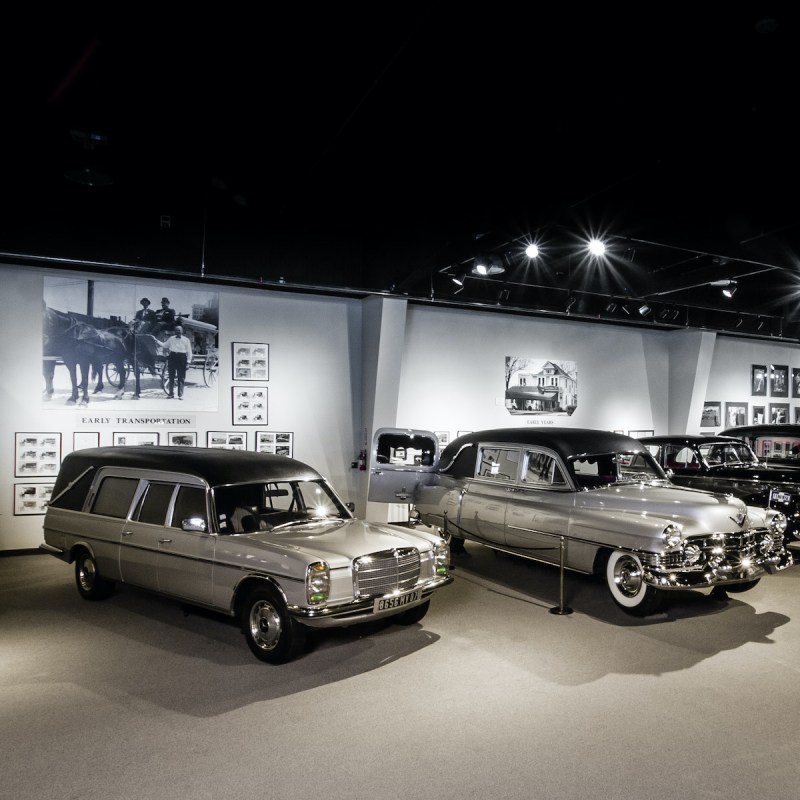
North Houston’s National Museum of Funeral History has this tagline: “Any day above ground is a good one.” The museum is the largest in the U.S. devoted to the care of the dead and isn’t morbid or creepy at all. In fact, there’s something for everyone. Yes, it sounds cliche, but it’s true — from American history buffs to car enthusiasts to the starstruck. Genevieve Keeney, the museum’s president and a mortician (meaning she is both an embalmer and funeral director) took the time to share the museum’s gems that are in the galleries for presidential, papal, and celebrity funerals, the 19th-century parlor, the international funeral display, and the impressive showroom for hearses.
Videos by TravelAwaits

1. President Washington’s Funeral Bill
The museum has memorabilia from each of the U.S. presidents who have died. Photographs and framed newspapers announcing the deaths of the commanders in chief cover the museum’s Presidential Funeral gallery. Funeral programs and personal effects fill display cases, all beginning with President Washington.
The neatly written invoice for George Washington’s funeral totals $99.25. A funeral oration by Major General Lee and eulogy by Judge Minot are on display as well. But perhaps the most interesting artifact is the newspaper page, in surprisingly good condition, that details Washington’s death and funeral. It says in part, “On Wednesday last, the mortal part of Washington the Great — the Father of his country and Friend of man, was consigned to the tomb, with solemn honors and funeral pomp.” Details on the President’s funeral occupy a column before moving on to advertisements for “Gold, Silver & white metal Medals bearing an exact likeness of the late General George Washington…”

2. President Lincoln’s Hair
President Lincoln’s funeral was the first state funeral in the U.S. Embalming allowed Lincoln’s remains to travel by funeral train from Washington D.C. to Illinois where he is buried. Mary Lincoln would normally have been expected to join her husband on the 14-day journey but chose instead to have their son Willie exhumed.
“A lot of milestones in our industry are showcased in Abraham Lincoln’s funeral, including embalming and the funeral train,” Keeney says. A replica of the train and carriage used to transport father and son is on display. A replica of Lincoln’s black casket decorated with silver medallions dominates the exhibit.
But looking more carefully at Lincoln’s memorabilia, you’ll see framed strands of hair. The doctor tending to President Lincoln when he was shot snipped a bit of his hair to get a better look at the wound. A display case below holds not only an original invitation to Lincoln’s funeral but also a Secret Service book that held the secret that John Wilkes Booth was not found and executed contrary to popular belief.
3. President George H.W. Bush’s Socks
The museum’s robust presidential display is due in large part to Robert Boetticher, a mortician and the museum’s chairman. Boetticher plans funerals for presidents, first ladies, dignitaries, and celebrities. The museum showcases memorabilia from the latest presidential funeral in the President George H.W. Bush Memorial Exhibit. The exhibit includes a replica of his funeral train. He was the eighth president to be carried by train, allowing mourners to pay their respects along the route. On a lighter note, a pair of Bush’s snazzy striped socks share space with a strand of Barbara Bush’s signature pearls.
4. Ground Zero Ashes
The City of New York gifted the museum with urns containing Ground Zero ashes and debris. They are part of a tribute to not only victims of 9/11, but also first responders who continue to die in the line of duty.

5. Pope John Paul II’s Sash
An entire exhibit hall is dedicated to the death of a pope, a display 3 years in the making with the help of the Vatican. Within, you’ll see Pope, now Saint, John Paul II’s embroidered sash, his vestments made by the same family of tailors who has outfitted the last seven popes, shoes, a replica of his simple, small wooden coffin, and replica of his grave in St. Peter’s Cathedral in Rome. The display walks visitors through the process of caring for and burying a deceased pope and the protocol for selecting his replacement.
6. A Three-Person Coffin
A distraught couple ordered a three-person coffin after their child died, making a pact to die by murder/suicide to join their little one. The custom casket took time to be built, and by the time it was delivered to the funeral home, the couple decided that any day above ground was better than the alternative.
After the husband passed away 20 years later, the wife requested a very belated refund. The unused 1930s coffin is on display.

7. You Can Take It With You Coffin
A coffin literally covered with U.S. coins and currency disproves the notion that you can’t take it with you. The shiny black casket is overlaid with $643 dollars in uncirculated bills and coins. It used to have $1,000 but was broken into.

8. A Yamaha Outboard Motor
The Life Well Lived exhibit gathers a collection of 12 fantasy coffins from Ghana — the largest collection outside of this west African nation. Seth Kane Kwe created the vibrantly painted, hand-carved wooden coffins, designed to immortalize the essence of the person, his or her occupation, or what the deceased hoped for in the afterlife.
The collection includes an odd assortment of objects and animals that outside of this context would never be linked: a lobster, KLM airplane, Mercedes sedan, shallot, leopard, fish, bull, and Yamaha outboard motor, to name a few.

9. Hair Art
Framed mourning hair art hangs in a 19th-century parlor showing a widow keeping vigil during a loved one’s wake. A display case holds human hair woven into watch chains. During Victorian times, a loved one’s hair was fashioned into art or jewelry as a way to keep that person close.
I was relieved to think this is no longer in vogue only to have Keeney say it’s making a comeback. And a quick Google search confirms the news. Artisans on Etsy can make custom hair or fur jewelry.

10. A Child’s Hearse
The museum’s hearse collection is impressive. The first one you see as you enter the museum is the hearse that carried Presidents Reagan and Ford. The collection continues with one-of-a-kind motorized hearses, like the handsome Rockfall hearse with hand-carved wood panels resembling swept-back curtains.
The oldest horse-drawn hearse, fully refurbished and dating from 1832, is prominently displayed as well. Keeney shows a horse-drawn hearse with interchangeable plumes. “The larger the plumes, the greater the socioeconomic status,” she says. The hearse carrying President Lincoln and his son Willie was topped with ostrich feather plumes. And black horses signaled the hearse carried a man while white horses indicated the deceased was a woman.
It’s the little more than half-sized pure white horse-drawn hearse that catches my attention. This hand-carved mini hearse conveyed children from their homes after the three-day wake (a waiting period in case the dead awakened) to the cemetery.

11. Marilyn Monroe’s Crypt
A replica of Marilyn Monroe’s crypt in Los Angeles stands in the Thanks for the Memories exhibit. The marble itself is real. The museum received this facade when it needed replacing. A steady stream of fans touching the stone wears it down. The brass nameplate is a replica, but the funeral program displayed next to the vault is the real thing.
Monroe is just one of the many people remembered in the Thanks for the Memories exhibit. You’ll see Charlie Daniels’ fiddle and Robin Williams’ hiking boots from the movie RV. Elizabeth Taylor and Michael Jackson mingle with Lucille Ball and Kobe Bryant. Frito Lay executive Arch West is remembered here because he gave the world Doritos. Enough said.
12. A Guessing Game
The museum’s newest exhibit includes post-mortem portraits and photographs. Mourning portraits began in the 16th century. Artists reportedly charged double to paint a dead person. After inventors learned how to capture images, families chose to memorialize their loved ones on metal and later paper.
Although many of the images on display are tintypes dating from the late 1800s, a daguerreotype image is dated April 24, 1865. It shows President Lincoln lying in his coffin. The coffin will look familiar at this point in your visit.
Some photographs, like Lincoln’s, show the deceased in a bed or coffin. Others, however, are dressed in their Sunday best and propped up in lifelike poses. You’ll see mothers holding children and portraits of all the family’s children including the deceased. The museum invites visitors to take a good look at the pictures with the help of a magnification glass and decide which person in the family portrait is, in fact, dead.
Pro Tips
- The museum is wheelchair accessible and open every day except Easter, Christmas Eve, Christmas, and New Year’s Day. For more information on hours, visit the website.
- When you visit this museum, plan for a minimum of 2 hours. Don’t be surprised if you’re there much longer.
- If you’re hungry for lunch, check out SouthernQ BBQ, a mile north of the museum.
